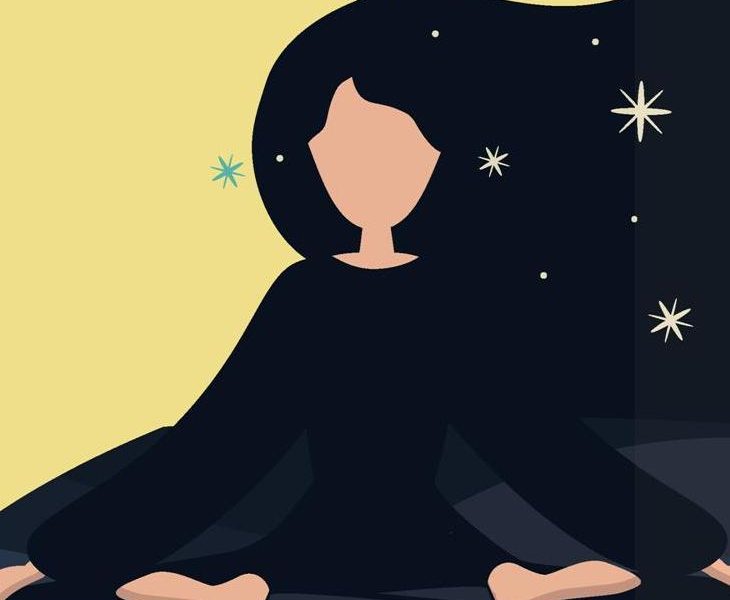Yoga teacher Kirsty Gallagher reveals her top poses for improved rest
Studies have shown that yoga can not only help you to fall asleep sooner but also improve the quality of your sleep. Practicing yoga before bed will help you to relax and relieve tension in your body, calm your mind and emotions and soothe your soul. Allowing yourself these few minutes to slow down and focus into the breath will help move you into a space of totally relaxed bliss ready for a deep restful night’s sleep.
Spinal rolling/rocking
This rocking and rolling movement is known for helping to eliminate tension and stress that may interfere with sleep. The massaging action on the spine helps to relax the whole nervous system, allowing tensions to be released and the whole body to become relaxed. The action is also extremely soothing to the mind and emotions.
1. Lay on a mat and draw your knees in towards your chest.
2. Start to very gently rock backwards and forwards along the length of the spine. You can make the rocking motions big or small as feels good, but remember this movement needs to be soothing rather than too activating.
Sukhasana with forward fold & twist (easy cross legged)
Sukhasana is well known for promoting inner calm and soothing and relaxing the mind. Adding the forward fold makes it even more calming and restorative and restores balance and equanimity in the body, heart and mind. A simple twist will also help to reduce any agitation in the brain or emotions. Make sure you do both sides to remain in complete balance.
1. Sit in a comfortable cross legged position on the floor. As described above, you can also fold forwards, resting your head on the floor, a chair or a block and just allow everything to relax. This will not only help to stimulate the pituitary gland but also any poses in which we are deeply supported and at rest will help to aid the adrenals.
2. You can also add a twist, by placing one hand behind the spine and gently placing the other hand on the opposite knee, allowing the body to gently twist. Imagine any stress and tension being released.
Supta Baddakonasana
This is one of the ultimate restorative yoga poses and, due to its deeply relaxing effect on the sympathetic nervous system, it is the ideal yoga pose to help calm anxiety, calm a scattered mind and soothe and comfort your heart and soul. Add blankets or bolsters under your knees and an eye pillow to enjoy the ultimate in total relaxation.
1. Lie down on your back and bring the soles of your feet together, allowing your knees to drop out to either side (you can bring the soles of your feet together from seated and then gently lie down if that’s easier).
2. Take your heels as far away from the body as you need to be comfortable and allow your arms to fall down by the sides with your palms facing up.
Viparita Karni (legs up the wall)
If you’re feeling overwhelmed and need a few moments of peace, this deeply restorative pose will help calm the mind, relieve anxiety and completely relax the entire nervous system. Combine this with long, slow full deep breaths and you’ll be drifting into a restful night’s sleep in no time.
1. Sit next to a wall with one of your hips resting next to it. Gently swing your legs around until they are up the wall with the backs of your thighs resting on the wall.
2. Slowly lower yourself down to lie on your back. Make sure your buttocks are as close to the wall as possible and rest your arms down by your sides with your palms facing up.
Stress-busting secrets
Getting a good night’s sleep is paramount to relieving stress but it’s often stress itself that is the cause of disturbed sleep. Write a list of all the things making you feel anxious so that they are out of your mind and on paper. Another way to reduce stress is to do the Nadi Shodhana Pranayama, which is great for quieting the mind, making it one of the best breathing techniques for insomnia. Follow the steps below:
1. Sit comfortably and allow your left hand to rest on your left knee. Tuck in the first two fingers of your right hand. The ring and little finger will be used to close the left nostril and the thumb to close the right.
2. Apply a slight amount of pressure (it doesn’t need to be much) to the edge of the nostril to close it. Take a few comfortable rounds of breath to begin with, just noticing the natural flow of your breath.
3. Take a deep inhale, exhale fully and at the end of your exhale close the right nostril with the thumb. Fully inhale through the left nostril. At the top of your inhale, close the left nostril with your little and ring fingers and release your thumb from the right nostril fully exhaling out of the right nostril.
4. Inhale through the right nostril and, at the top of your inhale, gently close the right nostril with the thumb, release the left nostril and exhale out of the left nostril. You have now completed one round of the relaxing Nadi Shodhana Pranayama.
5. Continue inhaling and exhaling from alternate nostrils, starting with an inhale left/exhale right/ inhale right/exhale left. Continue for a few minutes, ending with an exhale out of the left nostril and then release both of your hands and take a few moments to simply sit in stillness observing sensations of prana and enjoying the calm and stillness of your mind.




















